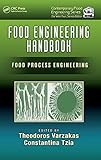Food engineering handbook. Food process engineering.
Language: Eng Series: Contemporary food engineeringPublication details: Boca Raton Taylor & Francis 2015Description: xxii, 650 páginas; Figuras, Ilustraciones, Gráficos 25 cmISBN:- 9781482261660
- 664 V327
| Item type | Current library | Call number | Copy number | Status | Date due | Barcode | |
|---|---|---|---|---|---|---|---|
 Libros
Libros
|
CIBESPAM-MFL | 664 / V327 (Browse shelf(Opens below)) | Ej: 1 | Available | 002714 |
Browsing CIBESPAM-MFL shelves Close shelf browser (Hides shelf browser)

|

|

|

|

|

|

|
||
| 664 / T266 Engineering aspects of food biotechnology. | 664 / T878 Fundamentos de tecnología de los alimentos. | 664 / V172 Problemas de balance de materia y energía en la industria alimentaria. | 664 / V327 Food engineering handbook. | 664.001 / M479 Análisis microbiológico de carne roja, aves y huevos. | 664.001579 / B662 Introducción a la microbiología moderna de los alimentos. | 664.001579 / F735 Higiene de los alimentos, microbiología y HACCP. |
Incluye bibliografía
Series Preface
Preface
Acknowledgments
Author Biographies
Contributors
Chapter 1. Membrane Separation; Alfredo Cassano, Renè Ruby Figueroa, and Enrico Drioli
Chapter 2. Size Reduction; Constantina Tzia and Virginia Giannou
Chapter 3. Centrifugation–Filtration; T. Varzakas
Chapter 4. Crystallization; T. Varzakas
Chapter 5. Mixing Emulsions; T. Varzakas, V. Polychniatou, and C. Tzia
Chapter 6. Solid–Liquid Extraction; Sofia Chanioti, George Liadakis, and Constantina Tzia
Chapter 7. Supercritical Fluid Extraction; Epaminondas Voutsas
Chapter 8. Chilling and Freezing; M. Giannakourou and V. Giannou
Chapter 9. Drying of Foods; Panagiotis A. Michailidis and Magdalini K. Krokida
Chapter 10. Fluidized Bed, Spouted Bed, and In-Store Drying of Grain; Dr. Srzednicki
Chapter 11. Fermentation and Enzymes; Constantinos Katsimpouras, Paul Christakopoulos, and Evangelos Topakas
Chapter 12. Fluid and Species Transfer in Food Biopolymers; Pawan S. Takhar
Chapter 13. Encapsulation of Food Ingredients: Agents and Techniques; Charikleia Chranioti and Constantina Tzia
Chapter 14. Multiphysics Modeling of Innovative and Traditional Food Processing Technologies; Kai Knoerzer and Henry Sabarez
Chapter 15. New/Innovative Technologies; George I. Katsaros and Petros S. Taoukis
Index
Food Engineering Handbook: Food Process Engineering addresses the basic and applied principles of food engineering methods used in food processing operations around the world. Combining theory with a practical, hands-on approach, this book examines the thermophysical properties and modeling of selected processes such as chilling, freezing, and dehydration. A complement to Food Engineering Handbook: Food Engineering Fundamentals, this text:
Discusses size reduction, mixing, emulsion, and encapsulation
Provides case studies of solid–liquid and supercritical fluid extraction
Explores fermentation, enzymes, fluidized-bed drying, and more
Presenting cutting-edge information on new and emerging food engineering processes, Food Engineering Handbook: Food Process Engineering is an essential reference on the modeling, quality, safety, and technologies associated with food processing operations today.
There are no comments on this title.
